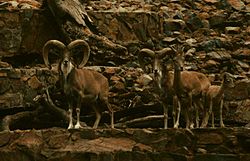Urial facts for kids
Quick facts for kids Urial |
|
|---|---|
 |
|
| Conservation status | |
| Scientific classification | |
| Kingdom: | |
| Phylum: | |
| Class: | |
| Order: | |
| Family: | |
| Genus: | |
| Species: |
O. orientalis
|
| Subspecies: |
O. o. vignei
|
| Trinomial name | |
| Ovis orientalis vignei |
|
The Urial (Ovis orientalis vignei), also called the arkars or shapo, is a type of wild sheep. It has reddish-brown fur that gets lighter in winter. Male urials have a black ruff (like a mane) on their neck and chest. They also have large, curved horns. You can find urials in western central Asia.
Urials are closely related to another group of wild sheep called the Mouflon (Ovis orientalis orientalis). Sometimes, scientists have thought these two groups were different species. Sadly, the Urial is an endangered animal. This means there are not many left in the wild.
Contents
What is a Urial?
A urial is a subspecies of wild sheep. A subspecies is a group of animals within a species that has small differences. These differences can be in how they look or where they live. Urials are known for their unique fur and horns. They are part of the Ovis orientalis species.
Where Do Urials Live?
Urials live in the mountains and hills of western central Asia. They prefer dry, rocky areas. These areas often have some grass and shrubs for them to eat. They are very good at climbing steep slopes. This helps them find food and escape from predators.
What Do Urials Look Like?
Urials have a reddish-brown coat. This fur can look lighter in the winter months. Male urials are easy to spot. They have a thick, black ruff of fur. This ruff goes from their neck down to their chest. Males also grow large, impressive horns. These horns curve backward and then around. Female urials have smaller horns or no horns at all.
Why Are Urials Endangered?
The Urial is listed as an endangered species. This means their numbers are very low. They face threats like losing their habitat. Their homes are sometimes taken over by human activities. Hunting can also reduce their populations. Efforts are being made to protect these special wild sheep. This includes creating safe areas for them to live.
Images for kids
-
Transcaspian arkals (O. v. arkal) at Pretoria Zoo
See also
 In Spanish: Urial para niños
In Spanish: Urial para niños



